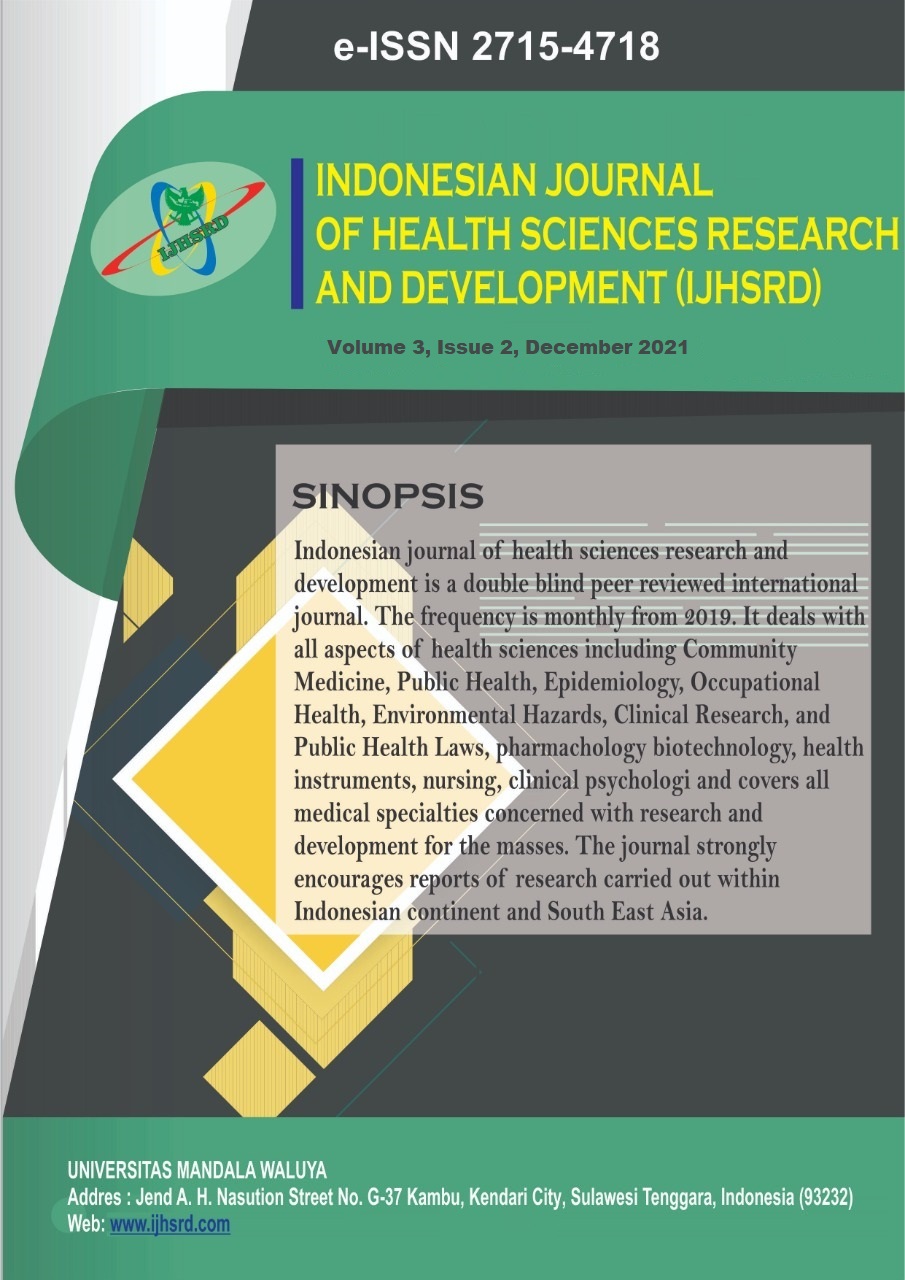Main Article Content
Abstract
Background: Based on interviews with 20 families who live in Tirawuta District, it was found that 11 people (55%) had never received counseling from health workers about the importance of using healthy latrines, 5 people (25%) could not provide latrine facilities, and 4 people (20%) said that for latrine needs, the mosque is located next to the house. The purpose of this study is to understanding the relationship of knowledge and health worker’s support with latrine using in Tirawuta Sub-District, East Kolaka District.
Methods: The research used quantitative method through a cross sectional study approach. The population of this study were all of the household heads who live in Tirawuta Subdistrict, Kolaka Timur Regency, namely 3,964 heads of households. A sample of this study were 94 people with a sampling technique using cluster random sampling.
Result: Based on the results of the X2 statistical testcount= 36.191> X2Table= 3.481 and the value φ = 0.620 which means that Ho is rejected and Ha is accepted, it means that there is a relationship of knowledge to the achievement of access to latrine use. X2count 20,821> X2table 3,481and the value φ = 0.471, which means that Ho is rejected and Ha is accepted, thus there is a relationship between support from health workers and the achievement of access to using latrines in Tirawuta Subdistrict, Kolaka Timur Regency.
Conclusion: There is a relationship between the knowledge and support of health workers and the performance of using latrines in Tirawuta Subdistrict, Kolaka Timur Regency.
Keywords
Article Details

This work is licensed under a Creative Commons Attribution-ShareAlike 4.0 International License.
References
- Afriani B. Faktor Lingkungan Berhubungan dengan Kejadian Diare Balita di Wilayah Kerja Puskesmas Muaradua Kabupaten Oku Selatan. Syifa'MEDIKA: Jurnal Kedokteran dan Kesehatan. 2015;5(2):99-106.
- Pujayanti DA. Industri Halal sebagai Paradigma bagi Sustainable Development Goals di Era Revolusi Industri 4.0. Youth & Islamic Economic. 2020;1(01):20-33.
- Omar YY, Parker A, Smith JA, Pollard SJ. Risk management for drinking water safety in low and middle income countries-cultural influences on water safety plan (WSP) implementation in urban water utilities. Science of the Total Environment. 2017;576:895-906.
- Unicef. The state of the world's children 2012: children in an urban world. Esocialsciences, 2012.
- Raksanagara AS, Fitriyah S, Afriandi I, Iskandar H, Sari SYI. Aspek internal dan eksternal kualitas produksi depot air minum isi ulang: studi kualitatif di Kota Bandung. Majalah Kedokteran Bandung. 2018;50(1):53-60.
- Mardotillah M, Gunawan B, Soemarwoto RS, Raksanagara AS. PERAN FAKTOR PEMUNGKIN DAN PENGUAT PADA AKSES JAMBAN SEHAT PERKOTAAN. Jurnal Antropologi: Isu-Isu Sosial Budaya. 2019;20(2):165-78.
- Anggraini E, Lisyaningsih U. Disparitas Spasial Angka Harapan Hidup di Indonesia Tahun 2010. Jurnal Bumi Indonesia. 2013;2(3).
- Akbar MI. Studi Kinerja Kepala Puskesmas Asera Kabupaten Konawe Utara. KESMAS UWIGAMA: Jurnal Kesehatan Masyarakat.2021;6(2):https://doi.org/10.24903/kujkm.v6i2.1004.
- Ridwan AR, Sahrudin S, Ibrahim K. Hubungan pengetahuan, personal hygiene, dan kepadatan hunian dengan gejala penyakit skabies pada santri di Pondok Pesantren Darul Muklisin Kota Kendari 2017. (Jurnal Ilmiah Mahasiswa Kesehatan Masyarakat). 2017;2(6).
- Apriyanti L, Widjanarko B, Laksono B. Faktor-faktor yang mempengaruhi pemanfaatan jamban keluarga di Kecamatan Jatibarang Kabupaten Brebes. Jurnal Promosi Kesehatan Indonesia. 2018;14(1):1-14.
- Latifah D, Mulyana N. Peran pendamping bagi orang dengan HIV/AIDS (ODHA). Prosiding Penelitian Dan Pengabdian Kepada Masyarakat. 2017;2(3).
- Chasanah SU. Peran Petugas Kesehatan Masyarakat dalam Upaya Penurunan Angka Kematian Ibu Pasca MDGs 2015. Jurnal kesehatan masyarakat Andalas. 2017;9(2):73-9.
- Kurniawati LD. Faktor-Faktor yang Berpengaruh terhadap Perilaku Kepala Keluarga dalam Pemanfaatan Jamban di Pemukiman Kampung Nelayan Tambak Lorok Semarang: Universitas Negeri Semarang; 2015.
